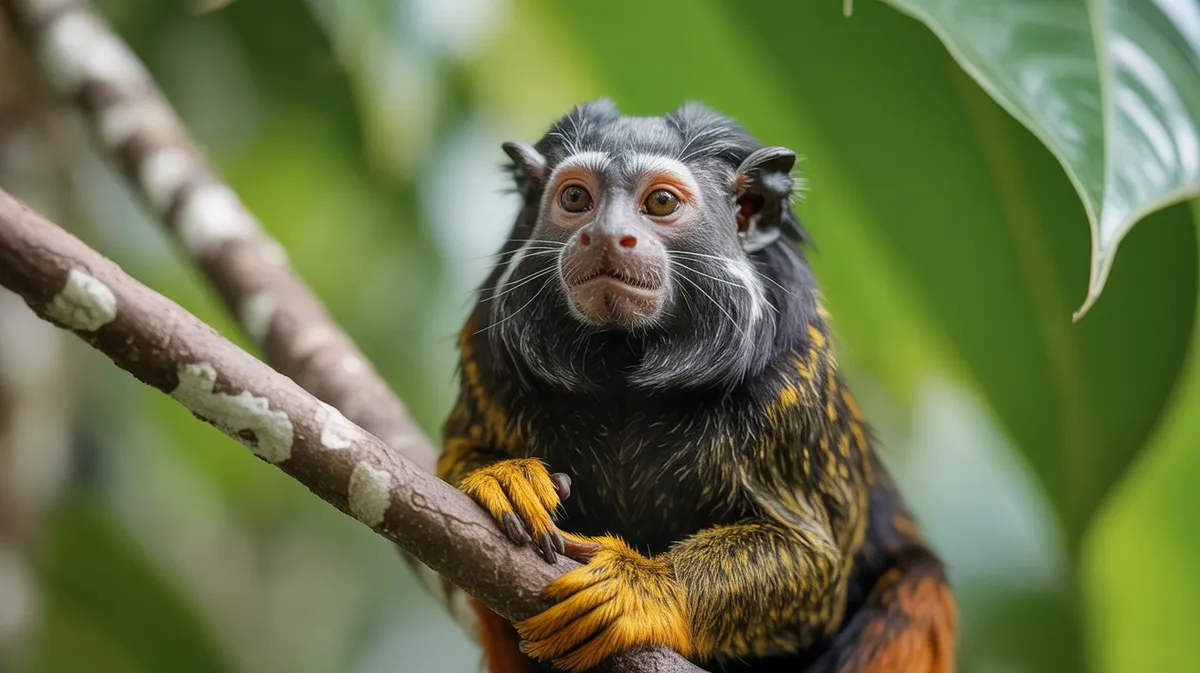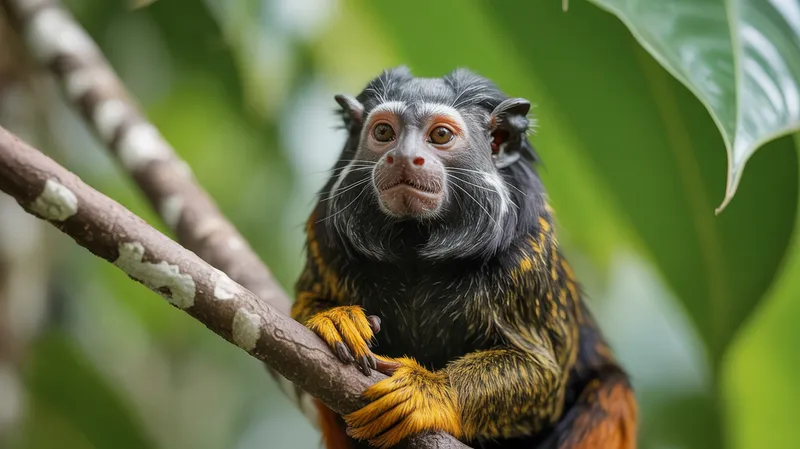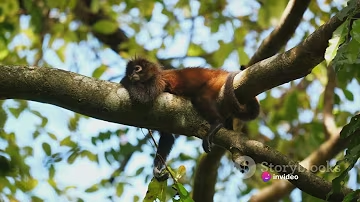
Red-handed Tamarin
Saguinus midas

Meet the Red-handed Tamarin
The Red-handed Tamarin is a small, agile primate known for its striking reddish-orange hands and feet that contrast with its sleek black fur. Native to the Amazon Basin, this tamarin is highly adapted to life in the treetops, using its long fingers and dexterous movements to forage for food. Social and energetic, red-handed tamarins live in small family groups and communicate through a variety of vocalizations and scent markings. They play an important role in their ecosystem by dispersing seeds and controlling insect populations.
Classification
Mammal
Habitat
Tropical rainforests, especially lowland and secondary forests
Diet
Omnivore
Lifespan
10-15 years
Conservation
Least Concern
Weight
400-550 g
📖Fascinating Facts
Distinctive Coloring
Their bright red-orange hands and feet provide a stark contrast to their otherwise black fur, making them easily recognizable among tamarin species.
Arboreal Lifestyle
Red-handed Tamarins spend almost all their lives in the trees, rarely descending to the ground and using their agility to avoid predators.
Social Structure
They live in cooperative groups of 4 to 15 individuals, sharing parenting duties and maintaining strong social bonds through grooming and play.
📋Detailed Description
The Red-handed Tamarin (Saguinus midas) is a small New World monkey, typically weighing between 400 and 550 grams and measuring 20–28 cm in body length, with a tail that can reach up to 40 cm. Its most distinctive feature is the vivid reddish-orange coloration of its hands and feet, sharply contrasting with its glossy black pelage. The face is hairless and dark, with expressive eyes and prominent ears. Adapted for an arboreal lifestyle, this tamarin possesses long, slender fingers and claws (tegulae) instead of nails, which aid in gripping branches and foraging for insects. Red-handed Tamarins are highly social, living in cohesive groups of 4 to 15 individuals, often composed of extended family units. Their communication repertoire includes high-pitched whistles, trills, and chirps, as well as olfactory signals from scent glands located on the chest and genital regions. Agile and acrobatic, they traverse the mid- to upper canopy in search of food, rarely descending to the ground. Their diet is omnivorous, consisting of fruits, nectar, flowers, insects, spiders, small vertebrates, and bird eggs. Reproduction is typically monopolized by a single dominant female per group, with cooperative care provided by other group members. Saguinus midas plays a crucial ecological role as both a seed disperser and a regulator of insect populations, contributing to forest health and regeneration.
💡 Did you know?
Despite their small size, red-handed tamarins can produce loud, piercing calls that carry through the dense rainforest to communicate with group members or warn of predators.
🔬Research & Sources
Wikipedia Summary
The golden-handed tamarin, also known as the red-handed tamarin or Midas tamarin, is a New World monkey belonging to the family Callitrichidae.
Last Modified: 4/8/2025
🎭Behavior & Social Structure
Red-handed Tamarins are diurnal and spend most of their active hours foraging, grooming, and engaging in social play. They exhibit a high degree of vigilance, using alarm calls to warn group members of predators such as raptors, snakes, and small carnivores. Foraging is often a group activity, with individuals searching for food in the bark, leaves, and epiphytes of trees. They display a preference for ripe, soft fruits but will opportunistically consume insects and small animals, using their dexterous fingers to extract prey from crevices. Social interactions are complex and include grooming, play-chasing, and scent-marking to reinforce group cohesion and establish territorial boundaries. Tamarins maintain overlapping home ranges of 25–50 hectares and may engage in vocal confrontations with neighboring groups. Rest periods are typically taken in dense foliage or tree hollows, where the group huddles together for warmth and protection.
👶Reproduction & Life Cycle
Breeding in Saguinus midas is characterized by a cooperative polyandrous system, though typically only the dominant female breeds. She may mate with multiple males, and all group members participate in infant care. The gestation period averages 140–145 days, after which the female usually gives birth to twins, though singletons and triplets are occasionally reported. Infants are born fully furred and with eyes open, weighing around 40 grams. The mother carries the infants for the first week, after which other group members, especially males, take over much of the carrying and grooming. Weaning occurs at 2–3 months, and juveniles reach sexual maturity at about 16–20 months. Breeding can occur year-round, but peaks are often observed during the rainy season when food is most abundant.
🛡️Adaptations & Survival
Red-handed Tamarins exhibit several key adaptations for arboreal life. Their claw-like nails (except on the big toe) provide a strong grip on vertical surfaces, facilitating rapid movement through the canopy. Their long, non-prehensile tail aids in balance during leaps of up to 5 meters between branches. Acute color vision allows them to detect ripe fruits and potential predators. Socially, cooperative breeding and alloparenting increase offspring survival in a habitat with high predation risk. Their omnivorous diet and flexible foraging strategies enable them to exploit a wide range of food resources, including those in disturbed or secondary forests.
📚Research Sources
🎨Cultural Significance
In indigenous Amazonian cultures, tamarins are sometimes featured in folklore as clever and agile tricksters. Their striking appearance and social behavior have made them popular in ecotourism and wildlife education programs. However, there is limited evidence of significant traditional medicinal or symbolic uses specific to Saguinus midas. In modern times, they serve as important ambassadors for rainforest conservation and are occasionally kept in zoological collections for research and public awareness.
🔬Recent Research & Discoveries
Recent genetic studies have clarified the phylogenetic relationships within the genus Saguinus, highlighting the evolutionary divergence between S. midas and its congeners. Field research has documented the species' role in seed dispersal, particularly for pioneer plant species in regenerating forests. Behavioral studies have explored the mechanisms of cooperative breeding and the hormonal regulation of reproductive suppression in subordinate females. Ongoing research is focused on the ecological impacts of hybridization with S. niger and the species' adaptability to fragmented landscapes. Additionally, Saguinus midas is used as a model organism in studies of primate cognition, vocal communication, and social learning.
🎥Wildlife Videos

Golden-Handed Tamarin Monkey | Expedition Guyana | BBC Earth
Wildlife cameraman Gordon Buchanan races from the camp to film the pint-sized golden-handed tamarin monkey. Standing at just ...
BBC Earth

Amazon The Red handed Tamarin
Unveiling the Amazon: The Red-handed Tamarin OUTLINE: 00:00:00 The Amazon's Hidden Treasure 00:00:57 The Habitat of the ...
PVergz TV

The Fascinating World of Red-Handed Tamarins | Midas tamarin
Welcome to our channel! In this video, we are delving into the fascinating world of the Red-handed Tamarin /Midas tamarin ...
WildPaws Planet

Red-handed Tamarin facts 🐒 Golden-handed Tamarin 🐒 Midas Tamarin 🐒
amazinganimals facts for kids The red-handed tamarin, also known as the golden-handed tamarin or Midas tamarin, is a New ...
Amazing Planet!

Did You Know? 25 Incredible Tamarin Facts
Tamarins form a family of monkeys which are characterized by their small size and long tails. Many of the species of tamarins that ...
Shop Like A Billionaire

Red handed Tamarin
animals information ================== blog http://www.athab.net/ weebly http://athab.weebly.com dailymotion ...
Animals
🌍Habitat Information
The Red-handed Tamarin typically inhabits Tropical rainforests, especially lowland and secondary forests environments. Red-handed Tamarins have adapted to their environments with specialized features and behaviors.
Primary Habitat:
Tropical rainforests, especially lowland and secondary forests
More detailed habitat information will be available soon.
🛡️Conservation Status
The Red-handed Tamarin is currently classified as Least Concern. Conservation efforts are crucial for preserving this species for future generations.
Common Threats:
- 🏠Habitat loss and fragmentation
- 🌡️Climate change impacts
- 🎯Hunting and poaching
- 🏭Human-wildlife conflict
⚠️Threats & Conservation Challenges
Although currently listed as Least Concern by the IUCN, Red-handed Tamarins face localized threats from habitat loss due to deforestation, agricultural expansion, and infrastructure development in the Amazon basin. They are sometimes captured for the illegal pet trade, although less frequently than some other primate species. Hybridization with the closely related Saguinus niger (Black-handed Tamarin) in areas of range overlap is an emerging conservation concern, potentially impacting genetic integrity. Climate change and forest fragmentation may also pose long-term threats by altering habitat structure and food availability. Despite these challenges, the species' adaptability to secondary forests and disturbed habitats has contributed to its relatively stable population trend.
🔬Scientific Classification
Scientific Name
Saguinus midas
Classification Hierarchy
🔍 About Taxonomic Classification
Taxonomic classification is a hierarchical system used by scientists to classify and organize living organisms based on shared characteristics and evolutionary relationships.
The system moves from broad categories (Kingdom) to increasingly specific ones, with each animal's scientific name typically consisting of its Genus and species.
📝Community Notes
Share your observations and insights about the Red-handed Tamarin with our community of wildlife enthusiasts.
Join Our Community
Sign in to share your observations and connect with fellow wildlife enthusiasts.
Sign In to ContributeNo community notes yet
Be the first to share your observations about the Red-handed Tamarin!
Explore Red-handed Tamarin
Select a tab above to learn more about this amazing animal.
📸Photo Gallery
No photos available for this animal yet.
🌟Discover More Wildlife
Continue your journey of discovery with more fascinating animals from our database
